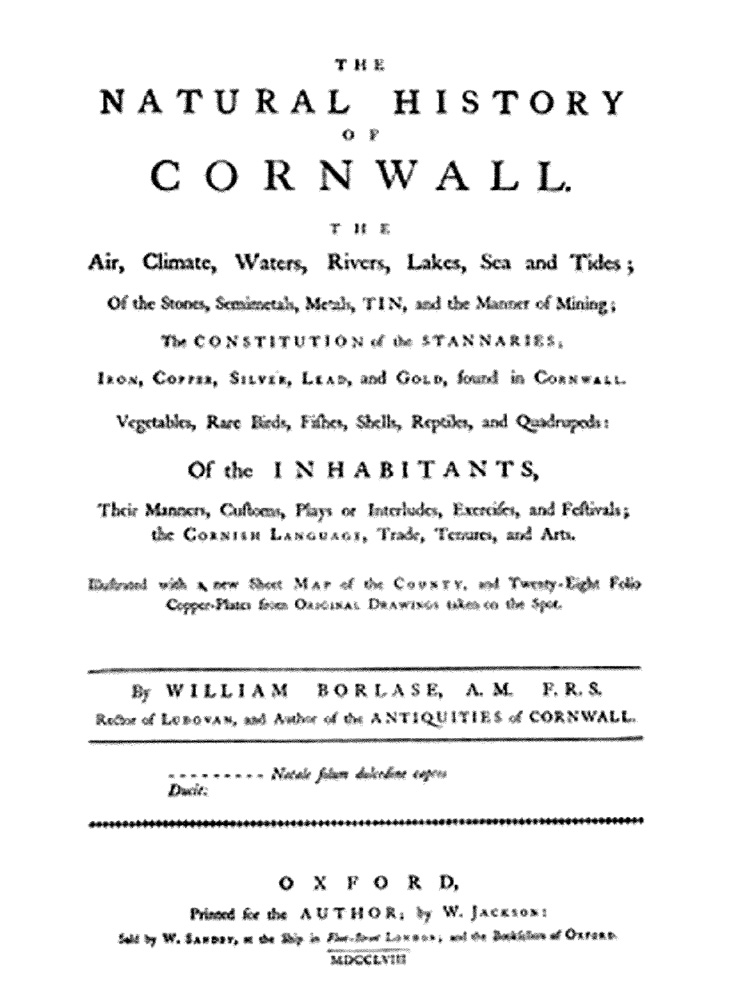BORLASE, William.
(1695 – 1772)
Borlase was born to an ancient family which could trace its roots back to the early Normans. His ancestors had settled in the parish of St. Wenn, Cornwall, where they adopted the Cornish name of their place of residence. He was first educated at a school in Penzance, but was moved to Plymouth. In 1712, Borlase entered Exeter College, Oxford, from which in due course, he earned the degrees of B.A. and M.A. In 1719 he was ordained a deacon of the church and in 1720 a priest. He was given responisbility of the parish of Ludgvan, near Penzance, where he seems to have first paided attention to the natural history and prehistory antiquities of the area. For his papers on the subject, he was elected to the Royal Society in 1750. Borlase published Antiquities of Cornwall (1st ed., Oxford, 1754) that contained many pertient observations of district with respect to early human habitation. As his next book, he published a much enlarged version of an earlier paper Observations on the Ancient and Present State of the Islands of Scilly, and their Importance to the Trade of Great Britain (Oxford, 1756). This was followed by the Natural History of Cornwall (Oxford, 1758), which is described below. Eventually, Borlase presented to the Ashmolean Museum of Oxford the whole of his collections of antiquities, fossils and minerals, which had been described in these works. In recognition of this generosity, the university bestowed a doctor of laws degree on Borlase, on March 23, 1766. Seven years later, he died, in the fifty-second year as rector of his parish.
Biographical references: BBA: I 126, 345-370; II 1321, 304. • DNB: 2, 860-1. • Encyclopaedia Britannica, 11th edition. • Gentleman's Magazine: 73, part 2, 1114-7. • Lambrecht & Quenstedt, Catalogus, 1938: 48. • Literary Magizine: 1756. • Nichol's Literary Ancdotes: 3, 78 & 689, 5, 291-303. • Poggendorff: 1, col. 242. • Pool, P.A.S., William Borlase. Truro, Royal Institution of Cornwall, x, 314 p.. • WBI.

1. English, 1758.
The | Natural History | Of | Cornwall. | The | Air, Climate, Waters, Rivers, Lakes, Sea and Tides; | Of the Stones, Semimetals, Metals, Tin, and the Manner of Mining; | The Constitution of the Stannaries; | Iron, Copper, Silver, Lead, and Gold, found in Cornwall. | Vegetables, Rare Birds, Fishes, Shells, Reptiles, and Quadrupeds: | Of the Inhabitants, | Their Manners, Customs, Plays or Interludes, Exercises, and Festivals; | the Cornish Langrage, Trade, Tenures, and Arts. | Illustrated with a new Sheet Map of the County, and Twenty-Eight Folio | Copper-Plates from Original Drawings taken on the Spot. | [rule] | By William Borlase, A.M. F.R.S. | Rector of Ludgvan, and the Author of the Antiquities of Cornwall. | [rule] | - - - - - - - - - Natale solum dulcedine captos | Ducit. | [ornate rule] | Oxford, | Printed for the Author; by W. Jackson: | Sold by W. Sandby, at the Ship in the Fleet-Street London; and the Booksellers of Oxford. | [short rule] | MDCCLVIII.
2°: π2 a-d2 B-Oooo2; 174l.; [i]-xix, [1], 1-326, [2] p., 28 plates, one map. Page size: 340 x 215 mm.
Contents: [i-ii], Title page, verso blank.; [iii]-vi, "To The | Nobility and Gentry | Of The | County of Cornwall, | ..."; vii-xii, "Some introductory Explanation of the Rise of the following | Treatise, ... | ... | To The | Candid Reader."; [xiii]-xvi, "A | List | Of | Subscribers."; xvii-xix, "A | Table of Contents."; [1 pg], Blank.; 1-326, Text.; [1 pg], "Errata."; [1 pg], "Directions | For Placing The Plates."
Very scarce. In this work, Borlase takes a generally conventional view of the Creation and Deluge in his descriptions of the natural wonders of Cornwall. Within the description are included many references to the diverse mineralogy of the region. He describes the lay of the land, air, weather, ground waters, rivers and estuaries, lakes and the surrounding sea, the earths, including soils, clays, steatites, etc., sands, husbandry, stones, including quartz, agates, jaspers, ornamental, spars, rock crystal, etc., semi-metals, bismuth, petroleum, antimony, manganese, loadstone, cobalt, mineral deposits and veins, metals, particularly tin and copper, birds, insects, fish, reptiles, quadrupeds and inhabitants. The map shows the region of Cornwall, and the other 28 plates picture various scenic vistas, crystals, figured stones, mines, apparatus, corals, insects, fish, shells, reptiles, and ancient coins.
Supplement, 1864: Additions to Borlase's Natural History of Cornwall. Royal Institution of Cornwall, 1864. 8°: 66 p., fold out facsimile illustration of Borlase's hand writing.
This is a 'Supplement' to Borlase's regional work and has been prepared `From MS Annotations by the Author.'
Facsimile reprint, 1970: The Natural History of Cornwall, 1758. Facsimile Reprint. With an introduction by Dr F.A. Turk. Biographical Essay by P.A.S. Pool. Appendix of additions from MS annotations by the author for a proposed second edition. 2°: xix, 326 p., 64 p., folding map, 28 plates. Limited to 350 copies.
Bibliographical references: LKG: XIV 423. • Porter, Making of Geology, 1980. • Roller & Goodman, Catalogue, 1976: 1, 143. • Smith, Early Mineralogy in Great Britain, 1978.
.